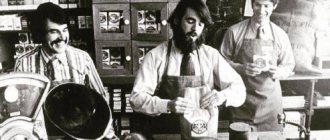The history of coffee goes back to ancient centuries, so until now it has not been possible to obtain accurate information about its origin. Nevertheless, some interesting legends have reached us.
History says that there were many opponents of the introduction of a strong drink into a person’s daily life, but the addiction to the invigorating potion still won. Today, coffee is in second place in sales on the world market and is second only to petroleum products in trade turnover.
The following material will briefly and clearly tell you about the history of coffee.
Different stories of the origin of coffee
There are several versions of the origin of coffee. The first version claims that the drink originated in Ethiopia. And the shepherd Kaldim, who was grazing goats, helped the Ethiopians learn about him. It was he who noticed how animals, after eating the leaves of a wild coffee tree, became overexcited. Kaldim told the abbot of the monastery about the amazing effect of the plant on goats. He became interested in the phenomenon and began to test the effect of the fruit on the body. Noting the invigorating effect of the coffee decoction, the abbot of the monastery began to recommend that his subordinates drink the drink in order to ward off drowsiness while standing in prayer. Local residents, having learned about the coffee tree, learned the recipe from the monks. Thanks to this, the coffee drink that originated in Ethiopia began its march throughout the world.
The second history of coffee remembers the reign of Sheikh Abd al-Qadir. Being a lover of scientific research, the sheikh paid a lot of attention to medicinal plants. Studying coffee as a remedy for headaches and poor bowel function, the sheikh in a written tradition compared it to a source of knowledge.
The next history of coffee concerns the ancestors of the Oromo tribe. It is known that African nomads, having discovered the power of the drink, constantly consumed it as food, and when they settled, they passed on their addiction to the local residents.
As you can see, the history of the discovery of coffee is ambiguous, since each legend offers its own theory of the origin of the drink. Today, only one thing can be said with confidence: the ancestor of the invigorating drink was most likely Ethiopia.
History of coffee: briefly about other countries of the world
Everyone knows that the coffee drink first became traditional in Middle Eastern countries. He fell in love with Europe a little later. The first plantation was planted in Yemen, when Arab traders brought raw materials. Next, Istanbul and Cairo became acquainted with the invigorating drink.
In the 15th century, the spread of coffee spread to Libya, Algeria, Morocco and Tunisia. After the destruction of the power of the Ottoman Empire, in the Arab Maghreb states, coffee raw materials from Yemen began to actively move to European countries.
Today, Yemenis proudly call the coffee drink their own. At the same time, they are silent that there was a time when in 1511 in Mecca, at the Council of Lawyers, a curse was placed on coffee in the name of Allah and the use of the “devilish intoxicating potion” was strictly forbidden. The reason for this policy was that with the spread of coffee in Arabia, cozy coffee shops began to open all around, where Arabs spent a lot of time on soft sofas, drinking a drink. Because of this, very little time was devoted to prayers. Then the ban on the drink was very strict; those who disobeyed could be drowned in a coffee bag, their tongue could be cut out. In some cases, people were even executed.
Atmosphere
You could spend the whole day in the cafe: drinking, having a snack, reading the latest newspapers, playing billiards, chess and dominoes. And they played for money, sometimes big ones. “Dominique” was famous for its chess and checkers tournaments. Future world champion Alexander Alekhine and Russian champion Mikhail Chigorin began their careers here. The latter wrote: “The player here must have strong nerves and a strong head... Stuffy, smoky atmosphere, noise from players of other professions.”
Dostoevsky's friend, doctor Alexander Riesenkampf, recalled how in February 1844 Fyodor Mikhailovich went to dinner at Dominic and lost his last hundred rubles to a sharper at dominoes.
Anton Chekhov did not play for money here, but preferred to kill a worm in pleasant company. He enthusiastically described his next visit to his brother Mikhail: “From the boat we went to Dominic, where for 60 kopecks. we ate a piece of pie, drank a glass and a cup of coffee..."
Mikhail Saltykov-Shchedrin was a true “Dominican” and often mentioned the cafe in his writings. In the satirical novel “Modern Idyll,” the establishment is presented as follows: “some red-haired individuals were always crowding at the door... an abyss of people, walking, wandering, one went out, another came in.”
The atmosphere of the famous cafe was accurately conveyed by Vladimir Makovsky in the canvas “At Dominic’s” (1910) and by Ilya Repin in the drawing of the same name (“At Dominic’s”, 1887).
In the 1960s, an ice cream parlor opened within the old walls.
The history of the appearance of coffee in European countries
The famous Italian doctor P. Alpini first wrote a lot about the coffee tree in 1591. The fruits of this tree became interesting to him after a research trip to Egypt. 25 years later, the first cafe appeared in Rome, opened by a representative of the Pope who lived for a long time in Iran. It was a stunning debut, after which Marseille and the beloved Venice took up the development of coffee craftsmanship.
By the middle of the 17th century, there were no townspeople in Europe who could not appreciate the miraculous drink, despite the fact that doctors in many cases did not recommend its use.
The interesting thing is that some coffee shops still exist. Suffice it to recall the famous coffee shop “Cafe Florian”, located on St. Mark’s Square in Venice. It was opened in 1720 and is still in operation.
In 1600, Pope Clement VIII could not resist the strange drink. Wanting to declare it “unclean,” the Lord’s servant decided to try it. The clergyman was so fascinated by the drink that he could not impose a ban on it.
The first coffee shop in England was opened by the Turk Pasca Rosi in Oxford in 1659. After which, English doctors universally advised drinking the aromatic drink, prescribing it for hysterics, stomach diseases, and also in cases where it was necessary to stimulate mental work.
Few people know that the history of coffee in Great Britain also contains memories of curious incidents. It is known that in 1674 only men were allowed to visit coffee houses. As a result, the women prepared a serious petition in which they condemned the use of coffee, because of which “husbands became eunuchs and gallant gentlemen lost their gallantry.” The men, having learned about such a petition, became ardent defenders of the slandered drink. The worried Charles II, having read the women's petition, issued a decree to close all coffee shops. But the decree was not executed, since the ruler quickly recalled it, fearing a wave of discontent among the stronger sex.
MENU “SNACK AT DOMINIC’S”
Kulebyaka with cabbage
Pie with meat
Biscuit for coffee
Kulebyaka with cabbage
The same one that was sung by the “Dominican” Nikolai Agnivtsev in the poem “Triptych”.
Ingredients: milk - 1 cup, butter - 2 partial cups. l., vegetable oil - 2 incomplete tbsp. l., eggs - 3 pcs. (1 for dough and 2 for filling), dry yeast - 10 g, salt - 1/2 tsp. l., sugar - 1 tsp, flour - 2.5 cups, cabbage - 400 g, onions - 1 head, carrots - 1 pc.
Recipe: Mix milk with yeast, salt and sugar, sift a glass of flour, mix and leave for half an hour in a warm place. Mix eggs with butter, add suitable dough base, add remaining flour. Knead the elastic dough and place it in a pan greased with butter. Leave for about an hour. While the dough is resting, prepare the filling. Chop the cabbage into thin slices, the onion into half rings, and grate the carrots on a fine grater. Fry the onion in vegetable oil, add carrots and cabbage. Pour water to simmer the vegetables. Boil the eggs until tender, cool and grate on a coarse grater. Season the cabbage with salt and pepper and mix with the eggs. When the dough has risen, roll it out with a rolling pin into a rectangular layer, leave the middle, and cut the edges on both sides into strips. Place the filling in the middle of the layer and cover the cabbage in strips one by one. Place the dough on a baking sheet covered with parchment and greased with butter. Leave for 10-15 minutes, then bake until golden brown.
Pie with meat
Ingredients: For the dough: milk - 100 ml, water - 100 ml, butter - 80 g, olive oil - 3 tbsp. l, instant yeast - 12 g, wheat flour - 550 g, eggs - 2 pcs., sugar - 1 tbsp. l., salt - 1 tsp. For the filling: beef - 0.5 kg, onions - 2 pcs., eggs - 4-5 pcs., salt, pepper - to taste; egg (white) - 1 pc.
Recipe: Mix milk and water and heat a little, add sugar, yeast and a tablespoon of flour. Cover and leave in a warm place. Sift 400 g of flour into a deep bowl, add olive and soft butter, salt, eggs and dough. Mix well, gradually add the remaining flour. You will get an elastic dough. Cover the bowl with the dough with a towel and leave for an hour. Prepare the filling. Boil beef and eggs and cool. Grind the meat using a blender or meat grinder. Cut the eggs into cubes. Cut the onion into cubes and fry until transparent. Add salt and pepper, stir. Knead the risen dough and divide into 12 parts. Roll each piece into a circle and add the filling. Pinch the edges of the pie and leave a hole in the middle. Line a baking tray with baking paper, lay out the pies, cover them with a towel and leave for 15 minutes. Beat the whites with a fork and brush the pies with a pastry brush. Preheat the oven to 200 degrees and bake for half an hour. Pour melted butter or hot broth into the prepared pies, 2 tbsp each. l.
Biscuit for coffee
Ingredients: eggs - 5 pcs., sugar - 160 g, rapeseed oil - 50 ml, flour - 160 g, salt - on the tip of a spoon, vanilla sugar - 1 tsp, baking powder - 1 tsp.
Recipe: Preheat the oven to 160 degrees. Grease the sides of the baking dish with butter. Cover the bottom with parchment paper. Sprinkle the mold with flour. Mix flour and baking powder and sift through a sieve. Beat eggs in a deep bowl. Add sugar and salt and beat until the egg foam is white and fluffy. Add vanilla sugar and beat for about another minute. Pour flour into the egg mixture. Add oil. Stir until smooth. Pour the batter into the pan and shake gently to pop any air bubbles. Bake for 40-45 minutes. Then turn the mold with the finished sponge cake upside down and place it on glasses, let it cool completely.
MAIL RUBRIC
History of coffee in Russia
The spread of the coffee drink dates back to the reign of Peter I. Having tried Dutch coffee, the emperor introduced the tradition of drinking it at meetings.
Back in 1740, the opening of the coffee house was initiated by Empress Anna Ioannovna. The first Moscow coffee shop “Pechkina” opened in the capital at the end of the 19th century. The bohemian public of that time called it a “reasonable place.”
Today our state is one of the ten countries where the described drink is very actively consumed. Statistics show that 85% of imported products come from the instant drink described.
History of the coffee drink: interesting facts about terminology
In England, the term "coffee" appeared in 1598. The British claim that they borrowed this word from the Dutch word koffie. Europeans say that they borrowed the name of the drink from the Turkish name kahve.
Ethiopians claim that the miraculous grain received its name due to the area where it grew (this is the Kaffa region).
An interesting fact is that Russians pronounce coffee (“coffee”) in the masculine gender. It has been this way since the time of Peter the Great.
As you can see, the history of coffee creation contains many secrets, as well as heated debates. It reflects years of tragic events and a period of intense interest in this drink. But be that as it may, the global popularity of coffee has been maintained for several centuries. And this is not surprising, because the magnificent taste and amazing smell of the drink excite the mind and remind us of the bohemian life of aristocrats.
Data
Interesting facts about coffee have appeared over the years, so now there are a great many of them known. Let's take a look at some:
- This drink is the most popular in the world.
- In Japan, a holiday appeared in his honor. Coffee Day is celebrated on October 1st. Japan ranks third in terms of consumption of this drink.
- There is a Musanga animal that eats only coffee beans, and its excrement is then used to make a drink. By the way, it is the most expensive in the world.
- The lethal dose is 100 cups per day. If you drink such an amount, a person’s heart will not stand it.
- Coffee, if you do not add sugar, cream and milk, is an absolutely calorie-free drink.
- When this drink appeared in Russia, people did not immediately recognize it. Therefore, supporters of Peter I began to invent stories about him so that he would become popular.
- A cup of coffee won't hurt anyone. It is believed that it is safe to drink no more than 500-600 ml per day, that is, approximately 3-4 cups of 150 ml.
- Drinking the drink helps prevent Parkinson's disease, dementia, and coffee, being a strong antioxidant, prevents the formation of cancer cells.
- Coffee is used in cosmetology. In some countries they take baths with it to make the skin elastic. There are also many recipes for scrubs and masks based on ground grains.
- This drink inhibits the development of gallstone disease.
- It can also cause heartburn. The reason for this is the acid contained in it.











